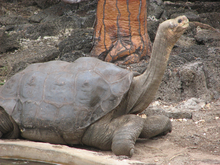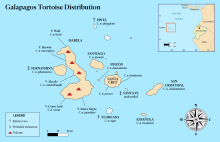Pinta Island tortoise
This article is missing information about full genome sequenced. (December 2020) |
| Pinta Island tortoise | |
|---|---|

| |
| Lonesome George at the Charles Darwin Research Station in 2006, the last known individual of his species of Galápagos tortoise | |
| Scientific classification | |
| Domain: | Eukaryota |
| Kingdom: | Animalia |
| Phylum: | Chordata |
| Class: | Reptilia |
| Order: | Testudines |
| Suborder: | Cryptodira |
| Superfamily: | Testudinoidea |
| Family: | Testudinidae |
| Genus: | Chelonoidis |
| Species: | C. niger |
| Subspecies: | †C. n. abingdonii
|
| Trinomial name | |
| †Chelonoidis niger abingdonii | |

| |
| Map of the Galápagos Islands showing locations of different tortoise species. | |
| Synonyms[3] | |
| |
The Pinta Island tortoise[4] (Chelonoidis niger abingdonii[2][5]), also known as the Pinta giant tortoise,[2] Abingdon Island tortoise,[1] or Abingdon Island giant tortoise,[2] is a recently extinct subspecies of Galápagos tortoise native to Ecuador's Pinta Island.[1]
The subspecies was described by
Taxonomy

Lonesome George, along with other of the tortoises on Pinta Island, belonged to a species of 15 subspecies. Giant tortoises were once found on all of the continents except Australia and Antarctica. The Galápagos tortoises remain the largest living tortoises.

The Pinta Island tortoise was originally described in 1877 by German-born British
Synonyms of Chelonoidis abingdonii include Testudo abingdonii Günther, 1877; Testudo elephantopus abingdonii Mertens & Wermuth, 1955; Geochelone elephantopus abingdonii Pritchard, 1967; Geochelone nigra abingdonii Iverson, 1992; and Geochelone abingdonii Valverde, 2004.[3]
Evolution
The origin and systematic relationships are still unresolved today; they captivated
Behaviour and ecology
In the wild, Galápagos tortoises, including the Pinta Island subspecies, rested about 16 hours a day.[citation needed] Galápagos tortoises are herbivores, they fed primarily on greens, grasses, native fruit, and cactus pads. They drank large quantities of water, which they could store in their bodies for long periods of time for later use. They can reportedly survive up to six months without food or water.[14]
For breeding, the tortoises were most active during the hot season (January to May). During the cool season (June to November), female tortoises migrated to nesting zones to lay their eggs.
Galápagos giant tortoises represent the top herbivores in the Galápagos, and as such they shape the entire island ecosystem. They provide critical
Relationship with humans
Threats and conservation
Several of the surviving subspecies of Galápagos tortoises are endangered. The decline of the population began in the 17th century as a result of visits by buccaneers and whalers. They hunted tortoises as a source of fresh meat, taking about 200,000 tortoises altogether.
In 1958, goats were brought to Pinta Island and began eating much of the vegetation, to the detriment of the natural habitat.[17][18] A prolonged effort to exterminate the goats was begun. As the goat populations declined, the vegetation recovered. Small trees began regenerating from the stumps left by the goats. Highland shrub subspecies, forest tree seedlings, Opuntia cactus, and other endemic subspecies increased. In 2003, Pinta Island was declared goat-free.[19]
In addition to conservation efforts such as the elimination of goat populations in the Galápagos, there has been an effort to revive a number of subspecies of Galápagos tortoise through captive breeding. Future efforts may aim to recreate a population genetically similar to the original Pinta Island tortoise by breeding the first-generation hybrids discovered on Wolf Volcano.

Lonesome George
The last known individual of the subspecies was a male named Lonesome George[20] (Spanish: El Solitario Jorge),[21] who died on 24 June 2012.[7][22][23] In his last years, he was known as the rarest creature in the world. George served as a potent symbol for conservation efforts in the Galápagos and internationally.[24]
George was first seen on the island of Pinta on 1 December 1971 by Hungarian malacologist József Vágvölgyi. Relocated for his safety to the Charles Darwin Research Station on Santa Cruz Island, George was penned with two females of different subspecies. Although the females laid eggs, none hatched. The Pinta tortoise was pronounced functionally extinct.
Over the decades, all attempts at mating Lonesome George were unsuccessful, possibly because his subspecies was not cross-fertile with the other subspecies.
On 24 June 2012, at 8:00 am local time, Director of the Galápagos National Park Edwin Naula announced that Lonesome George had been found dead[8][25][26] by his caretaker of 40 years, Fausto Llerena.[27] Naula suspects that the cause of death was heart failure consistent with the end of the natural life of a tortoise.
Possible remaining individuals
In 2006, Peter Pritchard, one of the world's foremost authorities on Galápagos tortoises, suggested that a male tortoise residing in the Prague Zoo might be a Pinta Island tortoise due to his shell structure.[28][29] Subsequent DNA analysis, however, revealed that it was more likely to be from Pinzón Island, home of the subspecies the Pinzon Island tortoise.[2][29][30]
Whalers and pirates in the past used
In May 2007, analysis of
The identification of eight individuals of mixed ancestry among only 27 individuals sampled (estimated Volcano Wolf population size 1,000–2,000)… suggests the need to mount an immediate and comprehensive survey… to search for additional individuals of Pinta ancestry.[33]
A subsequent trip to Isabela by Yale University researchers found 17 first-generation hybrids living at Wolf Volcano.[9] The researchers planned to return to Isabela in the spring of 2013 to look for surviving Pinta tortoises and to try to collect hybrids in an effort to start a captive selective-breeding program and to hopefully reintroduce Pintas back to their native island.[9]
In 2020, the Galápagos national park and Galápagos Conservancy announced that they had discovered one young female with a direct line of descent from the Chelonoidis abingdonii subspecies of Pinta island. [35]
See also
- Holocene extinction
- List of subspecies of Galápagos tortoise
References
Notes
- ^ . Retrieved 2023-01-22.
- ^ S2CID 88917646.
- ^ a b "Chelonoidis abingdonii (GÜNTHER, 1877)". The Recently Extinct Plants and Animals Database. Retrieved 2023-01-22.
- ^ Reynolds, Robert P.; Marlow, Ronald W. (1983). "Lonesome George, the Pinta Island Tortoise: A Case of Limited Alternatives". Noticias de Galápagos. 37: 14–7. Archived from the original on 2017-10-28. Retrieved 2012-06-26.
- ^ S2CID 87809001.
- ISBN 978-0330450119.
- ^ ISSN 0882-7729. Retrieved 2017-05-16.
- ^ a b Jones, Bryony (25 June 2012). "Lonesome George, last of the Pinta Island tortoises, dies". CNN. Retrieved 25 June 2012.
- ^ a b c "Galapagos Tortoise 'Lonesome George' May Have Company". LiveScience. 2012-11-15. Retrieved 2023-01-22.
- ^ "Breeding Efforts May Resurrect Giant Tortoise Species - Island Conservation". Island Conservation. 2016-07-26. Retrieved 2023-01-22.
- ^ a b c Günther, Albert Carl Ludwig Gotthilf (1877). The gigantic land tortoises (living and extinct) in the collection of the British Museum. British Museum, Dept. of Zoology, London: Printed by order of the Trustees.
- ^ "William Edgar De Crackenthorpe Cookson R.N." William Loney RN - Background (Officers in command) – via pdavis.nl.
- ^ "HMS Peterel". William Loney RN - Background (Mid-Victorian RN vessels) – via pdavis.nl.
- PMID 10557302.
- S2CID 52209043.
- .
- ^ "Galapagos Geology on the Web". Cornell University. Retrieved 2023-01-22.
- S2CID 247105.
- ^ "Lonesome George". Galapagos Conservancy. Retrieved 2023-01-22.
- ^ Gardner, Simon (2001-02-06). "Lonesome George faces own Galapagos tortoise curse". Archived from the original on 2011-06-04. Retrieved 2012-01-11.
- ^ Proceso de Relaciones Públicas de la Dirección del Parque Nacional Galápagos (2012-06-24). "El mundo pierde al solitario George". Archived from the original on 2012-06-28. Retrieved 2012-06-25.
- ^ "Lonesome George, last-of-his-kind Galapagos tortoise, dies". The Times of India. 2012-06-25. Retrieved 2023-01-23.
- ^ Raferty, Isolde. "Lonesome George, last-of-its-kind Galapagos tortoise, dies". MSNBC. Retrieved 2023-01-23.
- ISBN 978-1-4039-4576-1.[page needed]
- ^ "Giant tortoise Lonesome George's death leaves the world one subspecies poorer". National Post. Retrieved 2023-01-22.
- ^ Alexandra Valencia; Eduardo Garcia (2012-06-25). "Lonesome George, last-of-his-kind Galapagos tortoise, dies". Reuters. Retrieved 2023-01-22.
- ^ "Muere el Solitario George, la última tortuga gigante de isla Pinta". El Unveriso. Archived from the original on 2013-01-15. Retrieved 2012-06-24.
- ISSN 1556-5696.
- ^ ISBN 978-0330450119.
- S2CID 85200951.
- ^ Marshall, Michael (2012-06-26). "Lonesome George dies but his subspecies genes survive". New Scientist.
- ^ Nicholls, Henry (2007-06-06). "Galapagos tortoises: untangling the evolutionary threads". New Scientist.
- ^ S2CID 3055405.
- ^ "Iconic tortoise George may not be last of his kind". ABC News. Agence France-Presse. 2007-05-01. Retrieved 2023-01-22.
- ^ "Galápagos experts find a tortoise related to Lonesome George". The Guardian. Associated Press. 2020-02-02. Retrieved 2023-01-22.
Bibliography
- Caccone, Adalgisa; Gibbs, James P.; Ketmaier, Valerio; Suatoni, Elizabeth; Powell, Jeffrey R. (1999-11-09). "Origin and evolutionary relationships of giant Galápagos tortoises". Proceedings of the National Academy of Sciences. 96 (23): 13223–13228. PMID 10557302.
- Nicholls, Henry (2004-06-03). "Tortoise conservation: One of a kind". Nature. 429 (6991): 498–500. S2CID 32875557.
- Giant Tortoises Archived 2015-10-15 at the Wayback Machine, Galapagos Conservancy
- Recovery of a nearly extinct Galápagos tortoise despite minimal genetic variation., Wiley Online Library
External links
- Naked Scientists audio discussion of Lonesome George
- Article on Lonesome George The giant tortoise of Galapagos Island.
- Lonesome George, by Vicky Seal
- "Team of Veterinarians Prepare Hybrid Tortoises for Release on Pinta Island in 2010" (Press release). Galapagos Conservancy. 2010-02-03. Archived from the original on 2010-02-08.
- Garrick, Ryan C.; Benavides, Edgar; Russello, Michael A.; Gibbs, James P.; et al. (2012). "Genetic rediscovery of an 'extinct' Galápagos giant tortoise species". PMID 22240469.

